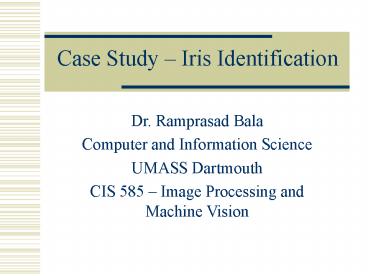Case Study Iris Identification PowerPoint PPT Presentation
1 / 15
Title: Case Study Iris Identification
1
Case Study Iris Identification
Dr. Ramprasad Bala Computer and Information
Science UMASS Dartmouth CIS 585 Image
Processing and Machine Vision
2
Person Identification
- Identification of person has always been an
important problem for our society commercial
and legal transactions. - We will describe a system to identify persons by
scanning the iris texture of an eye. - The sensing hardware for an ATM environment is
built by Sensar, which licenses from IriScan the
software that performs feature extraction and
matching.
3
System Requirements
- Three important biometrics are1. Fingerprint, 2.
Face, 3. Iris of the eye. - The system must obtain information with minimal
inconvenience - The biometric code must have little variance from
the same person over time. - The biometric code obtained from one person must
significantly vary from another person. - It must be very difficult to fool the system with
fake data, such as an image printed on paper. - The system must be cost effective relative to the
particular application.
4
Biometric Comparison
- Convenience in obtaining information
fingerprint (fair), face (good), iris (good), DNA
(poor). - Low interclass variance fingerprint (good),
face (fair), iris (excellent), DNA (excellent). - High interclass variance fingerprint (good),
face (fair), iris (excellent), DNA (excellent). - Difficult to fool fingerprint (good), face
(good), iris (excellent), DNA (excellent). - Cost effective fingerprint (fair), face (fair),
iris (fair), DNA (poor).
5
System Design
- ATM application authentication of the person
that owns or operates the account. - Careful scanner design and special optics are
needed in order to obtain a high-resolution image
of such a small object relative to the large 3D
FOV. (Need only to image the person in front of
the line 3D analysis). - Extract a 2048-dimensional binary vector Q and
compute Hamming distance (number of bits in which
the binary vectors differ).
6
(No Transcript)
7
(No Transcript)
8
Hardware Components
- Sensar Secure system is composed of four main
units - A general purpose computer that provides an
interface with an application process and the
sensing control and video (WFOV). - An optical platform with three cameras that
obtain both WFOV images and NFOV. - The control unit for optical platform
- The video processing unit which has special
hardware for real-time processing of stereo video.
9
- The two WFOV cameras obtain a video stream that
is used to locate the front most person in the
FOV. The two video streams are passed to the
signal processing unit, which performs the actual
stereo processing using multi-resolution
pyramids. - The x-y-z location of the designated eye of the
person is passed to the mail unit, which then
controls the optical platform so that it can
obtain the NFOV imagery of the eye. - This cycle can be performed every half second so
that a slowly moving person can be tracked. - The NFOV video is processed by the main units so
that the specific eye region can be located and
the iris code extracted.
10
(No Transcript)
11
Representation
- The ultimate representation of the eye and person
is just a binary vector of dimension 2048 (256
bytes of storage) 0 is printed black and 1 is
printed white. The eye image is normalized for
rotation before correlation is performed.
12
(No Transcript)
13
Performance
- The time for the system to acquire and identify
an iris scan varies with conditions and normally
is within the range of one to five seconds. - Nearly 90 of the time is spent on acquiring the
image. - After the image is passed to the algorithms, it
takes 200 msec to locate the iris boundaries and
to generate the IrisCode. - Matches proceed at the rate of about 100K persons
per second.
14
- If 70 of the 2048 bits must match in order to
verify that the person is the one claimed, then
the chances of accepting an imposter is 1 in 6 x
109. While the chances of rejecting the true
person is about 1 in 46,000. - If the threshold is reduced to 66, then the
false accept rate and false reject rate is about
1 chance in a million.
15
(No Transcript)

